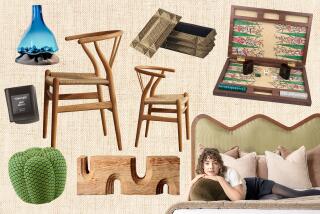Weâve certainly been âMadâ for modern
In its nearly eight years on the air, AMCâs period drama âMad Menâ became must-see TV for design professionals and decor fans and, arguably, a boon to the home furnishings industry. The interiors â conceived by production designer Dan Bishop and painstakingly appointed by set decorators Amy Wells in the first three seasons and Claudette Didul thereafter â explored a range of the popular styles of the â60s and early â70s.
Looking like rooms ripped from the pages of vintage magazines, there was the American Colonial Revival kitchen and French Provincial boudoir of Don and Betty Draper, Pete and Trudy Campbellâs chintz-infused suburban cottage, the Doris Day career girl look of Joan Harrisâ New York apartment and Megan Draperâs flower-power Laurel Canyon pad.
Yet it was Don Draperâs workplace and penthouse that resonated most powerfully, bringing Midcentury Modernism back into the mass-market mainstream and becoming a form of design shorthand.
âI cannot tell you how many meetings we have been to where the words âI want it to look like Don Draperâs office or apartmentâ have been uttered,â says Los Angeles interior designer Sarah Shetter.
Those sets in particular reinforced the enduring appeal of Danish Modern design and streamlined pieces by U.S. manufacturers such as Knoll, Herman Miller and Thayer Coggin, which revolutionized the way middle-class Americans furnished their offices and homes. âMad Menâ also helped re-popularize key midcentury designers Paul McCobb, Milo Baughman and Edward Wormley, who were once known only to vintage furniture dealers and collectors.
Manufacturers and retailers were quick to capitalize on the series, which ends its run Sunday on AMC.
âPeople recognized when they first saw the set decoration ... that modern did not have to be cold and monochromatic. It could be warm and livable. Midcentury Modern became part of our customersâ vocabulary,â says Raymond Arenson, executive vice president of merchandising and design at Crate & Barrel, which added Baughmanâs 1966 chair design for Thayer Coggin in leather upholstery to its offerings.
West Elmâs brass and wood Nook storage collection bears a strong resemblance to McCobbâs midcentury designs for Calvin Furniture. In 2014 the company launched the Peggy Collection of dowel-legged button-tufted sofas that have the prim modernity of the character portrayed by Elisabeth Moss. The company now has a full line of âMad Menâ-influenced furniture and accessories.
However, not everyone in the design community is convinced that the trend has been for the best. Midcentury Modern, often shortened to MCM, has become a buzzword, says designer Jason Martin, co-owner of Martin & Brockett in Los Angeles. âAnything remotely modern, from Bauhaus to 1990s contemporary, is incorrectly described as MCM now,â he says. Midcentury Modern has also become a default decorating style.
âThere seems to be a push to have this total retro look linked to a decade â the âMad Menâ effect â that is trending still, especially among people in their 20s and 30s,â says Ross Hamilton Englisbe of the Parisian design firm Hamilton Conte.
New York designer Louis Navarrete finds that it can be âslavish and timid â always white walls with an orange sofa, a slat coffee table and shag carpet.â
But Midcentury Modern is not going to go away, he adds. âThe designs are classic â even if the new versions are not as refined as the vintage ones â but I wish people would mix them with different periods and styles.â
The clean lines of mid-20th century furniture make such integration easy and eye-catching, says L.A. designer Kimba Hills. âIt blends nicely with more formal pieces from the 19th century and will blend in with the current Axel Vervoordt Belgian look and whatever the next trend is.â
When it comes to TV interiors, few designers expect there to be a show that can equal âMad Menâ for its trend-setting inspiration. âThe details and accuracy were so insane,â says Hollywood designer Jeff Andrews. ââMad Menâ kind of made me want to drink at work.â


